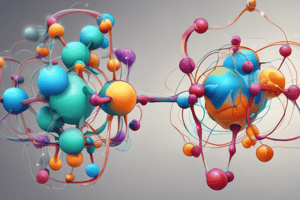Podcast
Questions and Answers
Which type of bond is characteristic of molecules like methane (CH₄) and molecular oxygen (O₂)?
Which type of bond is characteristic of molecules like methane (CH₄) and molecular oxygen (O₂)?
- Nonpolar covalent bonds (correct)
- Ionic bonds
- Polar covalent bonds
- Metallic bonds
In which molecules are polar covalent bonds found?
In which molecules are polar covalent bonds found?
- Methanol (CH₃OH) and acetic acid (CH₃COOH)
- Hydrogen peroxide (H₂O₂) and sodium chloride (NaCl)
- Water (H₂O) and hydrogen chloride (HCl) (correct)
- Ammonia (NH₃) and nitrogen gas (N₂)
What distinguishes double and triple bonds from single covalent bonds?
What distinguishes double and triple bonds from single covalent bonds?
- They involve the sharing of two or three pairs of electrons, respectively. (correct)
- They have a different geometry in molecules.
- They are weaker in strength than single covalent bonds.
- They involve the sharing of only one electron pair.
Which type of bond contributes to the unique properties of carbon compounds and ethene (C₂H₄)?
Which type of bond contributes to the unique properties of carbon compounds and ethene (C₂H₄)?
What do chemists use the study of chemical bonding for?
What do chemists use the study of chemical bonding for?
What type of elements form ionic bonds?
What type of elements form ionic bonds?
How do covalent bonds differ from ionic bonds?
How do covalent bonds differ from ionic bonds?
What happens to a metal atom during the formation of an ionic bond?
What happens to a metal atom during the formation of an ionic bond?
In covalent bonds, what does the octet rule state?
In covalent bonds, what does the octet rule state?
Which type of bond can be polar or nonpolar?
Which type of bond can be polar or nonpolar?
Flashcards are hidden until you start studying
Study Notes
Understanding Chemical Bonding: Ionic and Covalent Bonds
The origins of our comprehension of chemical bonding trace back to the 19th century, a time when scientists were grappling with the structure and constitution of matter while refining their understanding of atoms and their component particles. Two fundamental types of bonds—ionic and covalent—have emerged as the main organizational principles for chemical entities.
Ionic Bonds
Ionic bonds are formed between metal and non-metal elements through the transfer of electrons to achieve a stable electron configuration for both atoms. When a metal atom loses one or more electrons to satisfy the octet rule, it becomes a positively charged ion (cation). A non-metal atom, on the other hand, gains electrons to achieve the same octet, becoming a negatively charged ion (anion). The electrostatic attraction between these oppositely charged ions forms an ionic bond, resulting in the formation of ionic compounds with a characteristic crystal lattice structure.
Covalent Bonds
In contrast, covalent bonds form when atoms share electrons to achieve a more stable electron configuration. These bonds are based on the principle of the octet rule, wherein atoms strive to have eight electrons in their outermost valence shells. Covalent bonds can be polar, meaning the electrons are not shared equally between the atoms, or nonpolar, meaning the electrons are shared equally. Nonpolar covalent bonds are characteristic of molecules such as methane (CH₄) and molecular oxygen (O₂), while polar covalent bonds are found in water (H₂O) and hydrogen chloride (HCl).
Double and triple bonds can also form from covalent bonding, with two or three pairs of electrons being shared between atoms, respectively. These multiple bonds are indicative of stronger bonding and contribute to the unique properties of molecules like carbon compounds and ethene (C₂H₄).
Summary
In summary, our current understanding of chemical bonding is characterized by two main types of bonds—ionic and covalent. These bonds form the basis of matter's organization into stable molecules, ions, and crystals, each with unique properties and reactivity. The concept of chemical bonding, while inherently simple, has a rich and nuanced history, extending from the era of classical physics to the realm of quantum mechanics. The study of chemical bonding has provided chemists with a powerful tool to understand, explain, and predict the behavior of matter.
Studying That Suits You
Use AI to generate personalized quizzes and flashcards to suit your learning preferences.




